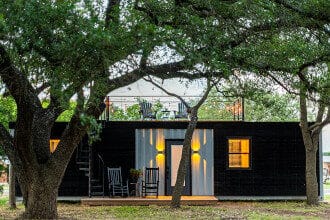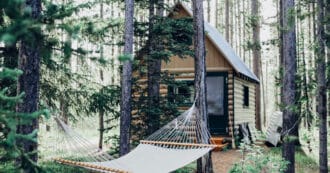By Rachel Cohen – A self sustaining home is able to supply its own energy, water, food, and sewage. It’s uncommon to find many homes like this but as more individuals are becoming aware of the impact of global warming we may see a trend towards this model of living.
Why Live In a Self Sustaining Home?
There must be a reason why people are turning to life in self sustaining homes. Let’s take a look at some of the advantages.
Bill Free Lifestyle
One benefit of living this lifestyle is you will be able to live bill free. As you’re not relying on companies to have access to electricity, heating, gas, or sewage you will automatically save money.
Many think that living sustainably can be costly, yet it can actually save money. The money saved on electricity, heating, gas, or sewage can leave room in a budget for other bill-reducing activities such as solar power.
Low carbon Footprint
Another draw to this lifestyle is that it will drastically cut your carbon footprint. In 2020, “the average annual electricity consumption for a U.S. residential utility customer was an average of about 893 kWh per month.”
That is the electricity use of just one household. Multiply that by the 300,000,000 people living in the US and we understand that current lifestyles are completely unsustainable. It’s even more drastic when you include the consumption of the entire world.
How Is a Self Sustaining Home Self Sufficient?
Solar Panels
A self sufficient home uses a variety of means to make “off grid living” possible. One of the most common practices is using solar panels to create energy for the house.
There are large benefits of solar power which is why many organizations have worked to make it more accessible. Government agencies, local nonprofits, and even state governments work towards solar accessibility.
There are many grants for homeowners in low income or rural areas for solar panels. By making alternative energy options more affordable it can help induce this kind of life style.
Water Management
Another aspect of self sufficient living is having an independent water supply. In the style of off grid living, a home would not be connected to town water, meaning a homeowner would need to find their own source for water.
One of the easiest ways to do this is through having a rainwater collection system. After collecting rainwater, it would need to go through a filtration system which will make it useable.
Rainwater collection can be as simple as leaving buckets outside your home to catch runoff. There are also more intricate rainwater systems such as a dry system.
Another option for self sufficiency water is to dig a well. This is not always possible depending where a home is located. By working with a local water company you will be able to discover possible usable water underneath the ground which will allow for a well to be dug.
Energy Production
Many off grid homes will use a wood burning stove to make their own heat to warm the home and water. Using wood consumes less energy than traditional heating methods.
Wood burning stoves that are certified by the Environmental Protection Agency (EPA) are up to 50% more energy efficient. The energy efficiency and self sufficient practices help make these homes better for the environment.
Energy efficient homes
For many, it’s too daunting or unrealistic to build a self sustaining home. Rather, there are small changes individuals can make in their lives to have a more energy efficient home.
Self sustaining may be the ultimate goal, but any action towards reducing a carbon footprint is important. Each step towards reduction of green house gases makes a difference.
Making An Energy Efficient Home
Passive Lighting
If your home already has large windows you can use this to your advantage. Large windows act as natural light which eliminates the need for unnecessary overhead lights.
Overhead lights use energy and can raise the temperature in a room which leads to the use of air conditioning with its own environmental impact.
Energy Efficient Products
Another change can be switching to more energy efficient products. There are washers and driers that use less energy and water consequently creating less impact on the earth.
If you cannot get newer products, try washing your clothes on a cold setting. By using cold water, you’re reducing the energy consumption of the utilities, thus lowering your carbon footprint.
Lightbulbs are another small change. Using a LED lightbulb is better for the environment than traditional lightbulbs. This is due to the bulbs not containing mercury which is an extremely harmful element.
Insulated Windows
Insulated windows can make your home more energy efficient. Insulated windows help to keep cool air in during the summer and keep cold air out during the colder months.
This simple tip can reduce how much energy you use to heat or cool your house down, resulting in a smaller environmental impact. Small actions like this can add up and lead to great impacts.
Insulation
Good insulation is another key aspect of making your home more energy efficient. Insulation works similarly to insulated windows. It helps to keep the cold air out or warm air in, again resulting in needing less heating or cooling.
Other Low Impact Living Options
A self sustainable home is not the only way to live a low carbon foot lifestyle. There are other options as well. For an interesting example, check out another blog post from ICSD that talks about school bus conversions.
Tiny Homes
There is a movement toward tiny homes. Living in a tiny home reduces one’s carbon footprint, materialistic consumption, and the amount of earth dug up to house the tiny home.
Tiny homes can be made out of a variety materials including shipping containers. Simple living like this can be even more ecofriendly than living in a self sufficient home.
Looking Forward To Self Sustaining Lifestyles
There is no guarantee that people will move towards the self sustaining lifestyle, but a general trend toward environmentally friendly living can be seen. According to a survey of Australians and Americans, 77% want to learn how to live a more sustainable lifestyle.
The world is at a tipping point where each choice we make has a great impact. Working towards making your home a little more sustainable can have a large impact on the environment.
Religion and The Self Sustaining Home
A recent article in ArchDaily describes the amazing advances that Japan is making towards creating self-sustaining homes. The impetus is coming from the government, and the designers are rising to the challenge:
In April 2014, the Japanese government approved an energy policy to encourage Zero Net Energy Houses (ZEH) to become the standard for new house construction by 2030. Zero energy housing is designed to consume as much energy as it can create using renewable energy on-site.
The article explore various new designs that are both beautiful and highly efficient. The fact that these efficient innovations are coming from Japan is no surprise. Japanese Zen Buddhism and Shintoism focus on inner peace through material order and simplicity. As described on Mukuomo, “Japanese minimalism encourages a serene, simple and uncluttering lifestyle, emphasizing strongly on balance, mindfulness, simplicity and nature.”
Creating simple, self sustaining homes is a great way to find balance between humanity and nature and thereby bring spirituality to life.
* Featured image source






